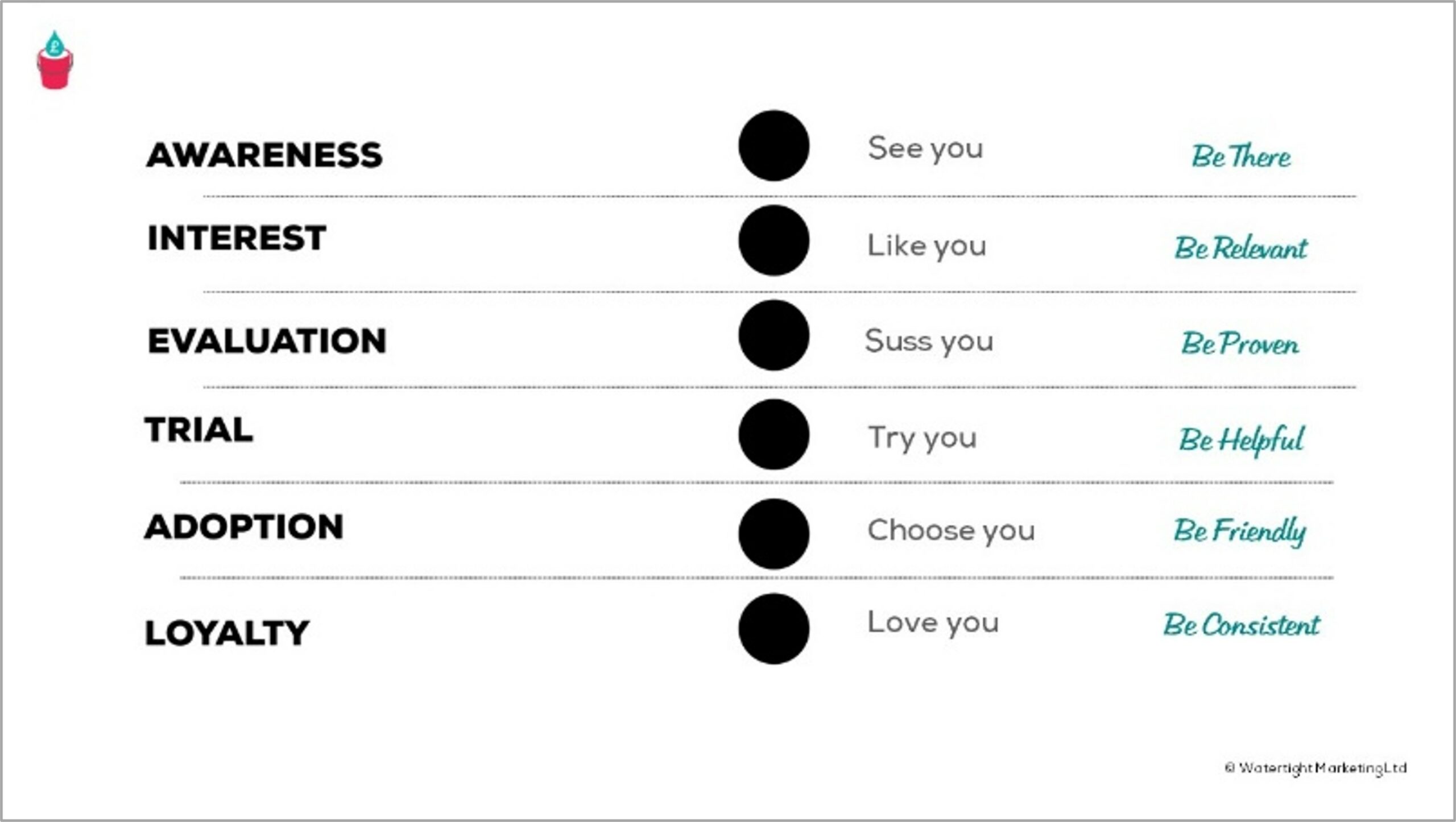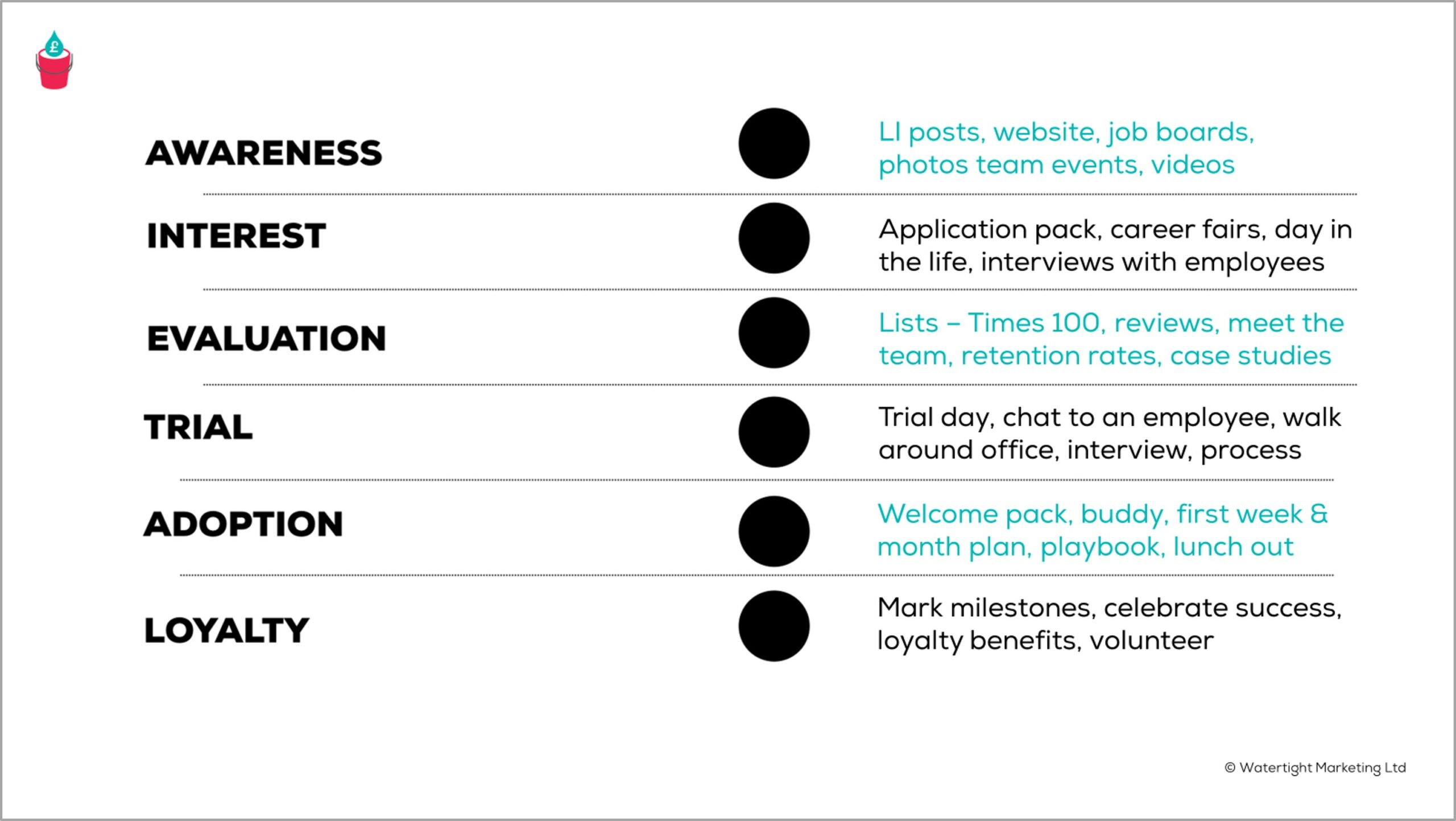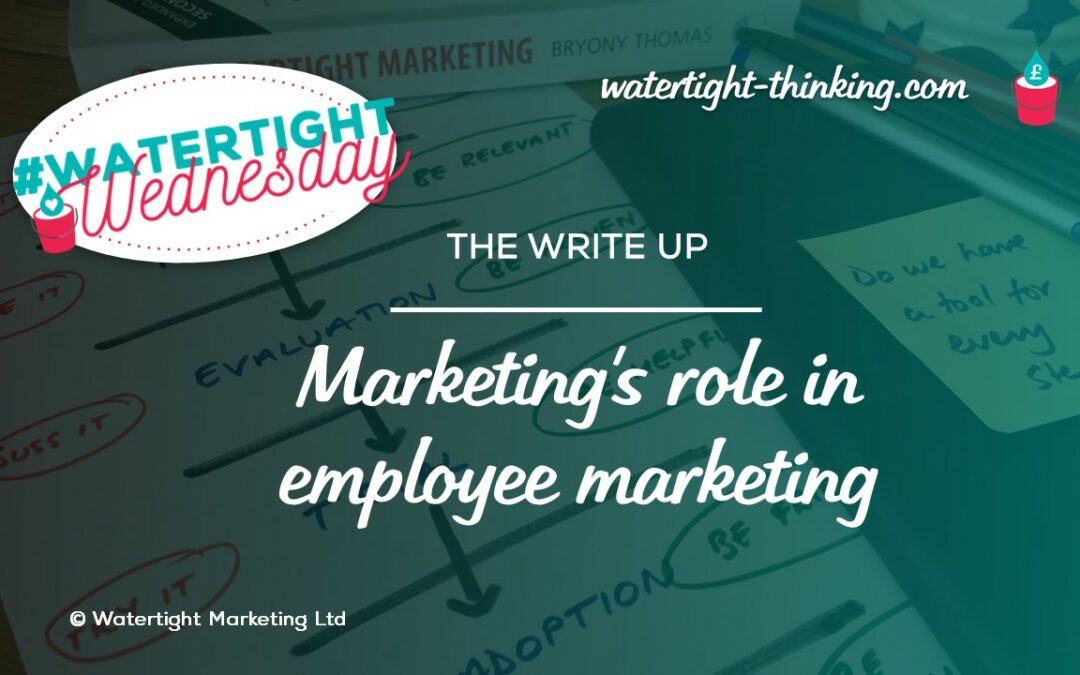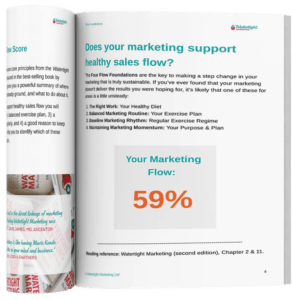Reading Time: 10 Minutes
Listen to the session podcast here
55-minute roundtable discussion on marketing’s role in recruiting brilliant employees.
The importance of getting clear on your vision, values and milestones
Following on from that starting point, this is the first strategic consideration. It’s as important for employer marketing as it is for customer marketing. The lens we use is our Fourth Flow Foundation – Maintain Momentum where “keeping up enthusiasm is made possible by a compelling business vision that is translated into a clear plan.” (Our definition)
People increasingly want to work for companies who make a positive contribution to the world, are purpose-led, have values which they’re proud of and which employees can buy in to.
Explaining where the company is going, employees’ part in that plan, your values and what it means for people in practice, behaviours you expect and your culture all help to paint a picture of what it’s like to work there and how you treat people. Be warned, however. This needs to be a true reflection of your company and more than cosmetic. Make sure your vision and values come out in your employer marketing to give prospective employees a clear and genuine sense of what you’re about and why you’re an attractive option for them. It will be a big appeal for the right candidate.
Barry Fleming: “The start point for me is that within those organisations, what they describe as their values and behaviours and how true they are, is a big issue. A lot of organisations put values on their walls; sometimes they haven’t evolved from within, based on the strengths of that company. It’s more that they’ve seen other organisations show their vision and values, so they think they have to do the same. It can become quite generic, and cosmetic as well.
Rachael Wheatley: “I think that’s problematic on two fronts. One is because existing employees will just not see that as being true. The other is because future employees who then join will quite quickly see that it isn’t true, and will be massively disappointed. That’s why I believe it needs to be sorted first, internally, before you go out and recruit.
Peter Baynes: “I was involved in an exercise with a company who did a customer survey and a staff survey, asked about values, and what people felt about the company. The customers would say there was some breakdown in proactive support, for example; we said, we need to be proactive, to build it into our values, that people take ownership and responsibility. So made those values that the customer wanted to be real, and put actions in place, for them to be lived. And that was a marketing-led exercise.”
Rachael Wheatley: “I think that’s really key. Anything you come up with, whether that’s vision or values, needs to be threaded through everything. So thinking, how does this impact on our recruitment process? How can we thread this through into the teams, not just behaviours? Where do we need to see values coming out, in what areas of the business to make them more than surface?”
Peter Baynes: “Exactly. And how do you use those values to attract customers and employees? I’ve got two daughters who are new into the workplace. And they have said: I want to work with companies whose values I share and that values me. I think that’s a generational thing.”
Rachael Wheatley: “That talks to Helen’s point in the chat. If it’s a company that says it supports diversity, equality and inclusion, then you need to back that up by saying, we offer remote or flexible working, be really transparent about your salary bands, for instance.
The importance of understanding what a good employee fit looks like
The second strategic consideration is to do with “a healthy employee mix”. Our definition: “a healthy employee mix is one that is made up of those that serve both purpose and profit, ensuring your business is energised and resourced.” Who will be proud to work for you? Who will be productive in their role?
Be clear about what characterises employees who thrive in your company. What do they value and is that in line with your company? How do they like to work and does that fit with you? Encourage them to be honest and open about what they want – it is, after all, a two-way decision. Look at how well you qualify applicants by these criteria and put them in the person specification. The more transparent you are, the more likely you are to find a candidate that fits.
Rachael Wheatley: “At the moment it is a candidate’s market. So the way you stand out and what people will choose is more likely to be emotional than it is logical. They will go with what feels right, with what matches how they work and where they feel they can be happy.
Isobel Horswell: “I think younger candidates are mainly focusing on salary and progression. That is a very important hygiene factor. It is also a benefit if you can get the right cultural fit and you align with their vision. The feedback I’ve had from some of the professional services firms that we’ve been with recently has been very much that the younger generations are quite happy to move companies regularly for the promotion and the salary opportunities, irrespective of whether it’s a great company. They don’t seem to have the same loyalty.”
Alex Waite: “It definitely rings true across the agency world. People get promotions by leaving their job. Not many people stick around; they’ll do 18 months, two years, and then look to leave to get a promotion, as opposed to longevity or loyalty.”
Rachael Wheatley: “I’m hypothesising here, but I wonder what the correlation is between their propensity to move and how happy they are in that particular company. If you were really happy in your company, might you be more likely to say to your boss: I’d really love to stay, but, what are the career or development opportunities within this company. It’s not necessarily ascending the career ladder but it could be broadening your experience to position you better to get a more senior job.”
Barry Fleming: “It’s a function of the commercial structure of the business. There’s not so much scope for developing [in smaller companies]. In large organisations they have space to enable people to move around within departments.”
Rachael Wheatley: “Yes, that’s true. And I’ve always thought it’s better to have a really productive, engaged employee for two years, and then they move on. As long as you can make their time there happy, then they’ll talk well of you.”
Samantha Gosrani: “From a people perspective, I completely agree with that. We’ve brought someone into my team who I’m quite convinced won’t stay for much longer than two years. But actually, it’s what I wanted: someone that’s going to have the hunger, real enthusiasm and engagement for a brief amount of time. And if then, they have to move on because we don’t have a position for her to move up into, then, so be it.”
Peter Baynes: “That loyalty piece, keeping staff on board is achieved when companies invest in them, train them, give them opportunities and reward them with salary increases. There is always that fear that if you train and invest in them, they’ll leave. They’re going to leave anyway if you don’t do that. And having that culture of investing and training people is evidence to recruit new people as well that it will be part of their career progression.
How marketing supports the employee’s journey
The third consideration is why and how marketing can play a role. A straw poll of attendees found that around 50% of marketers are involved in employer marketing. Those who are not I would argue need to have at least an advisory role – marketers have a lot to add to the whole process of finding, appointing and keeping happy staff. After all, it’s hard to deliver great products and consistently excellent customer service if your employees are disengaged and disenchanted. And how your marketing positions the company has an impact on future employees as well as potential customers.
This journey is supported by marketing tools and techniques. The job advert, the application pack, the care with which these are written and presented, the interview, the process of appointment, how you on-board new employees, how you communicate internally – all of this is “marketing” whether your HR department know it or not!
So what kinds of marketing supports that journey? This was one of the things we discussed; Rachael reframed the six stage journey for employer marketing, though the job of marketing remains the same:

These tasks – Be There, Be Relevant, etc – are a useful guide when thinking about the marketing you’re putting in place to engage with prospective employees. Use this lens to decide which marketing tools and techniques will best do the job in hand. Here are some ideas:

Barry Fleming: “My experience with employer marketing is that it’s inconsistent. Some of those activities are there, mainly driven by the HR department. It tends to be a functional, logical approach – here’s the job role, here’s the salary, here’s the person spec. It’s more about a process, trying to identify people with the right skill set.”
Rachael Wheatley: “So it’s not done from an emotional connection point of view, looking at why this person will actually want to come to our company.”
Barry Fleming: “No, it’s about can they do this particular job, given their previous experience and their skill set, if so, they’re probably right for us. Obviously, during the interview process, the recruiting manager might dig more into this person’s fit with the team, how the business looks, the culture, the way we do things.”
Rachael Wheatley: “Thinking of that initial advert where you want to pique people’s interest, I wonder if companies taking that more logical approach are missing a trick.”
Samantha Gosrani: “Interestingly, we have just spent six months reviewing our job adverts. We write them quite differently now. We do spend more time talking about the type of person we’re looking for and what a day in the life looks like, rather than a job advert that lists all the responsibilities. Because that was making us stand out quite differently from what’s out there. We have a summary job description that we now attach to the job advert that gives a very brief overview of the kind of key responsibilities. Later down the recruitment process, we give them a longer job description that really breaks it down and gives a lot more detail. But in the actual job advert, we do talk more about what your day would look like, what kind of person you are, the sort of skills that you might bring to us, and how that would fit.”
Alex Waite: “I work for a creative agency. We’re a small business and it’s not been marketing’s responsibility to lead on the employer marketing. One of the things we’ve really come up against now is looking at future talent. It’s a seriously tricky area for a number of agencies and a lot of businesses; getting the right type and calibre of person is becoming ever more competitive. One of the things I was recently looking at was job ads. I think it is a really good opportunity to put across a bit of personality. A lot of the time, it does look quite dry and leads on benefits and things like that. To a certain degree, I think that’s table stakes. The emotional side of things, and the personality you can put across is the sort of the thing that in my mind potentially wins people over.”
Rachael Wheatley: “Another comment in the chat about when costs are tight, companies are focused on the client experience, which can mean they neglect their staff experience in terms of progression and career path. I don’t see how you can have happy clients if you don’t have happy people.”
Peter Baynes: “It goes back to Virgin modelling themselves on Southwest Airlines in the US. All their marketing spend was spent on customer staff training to ensure the staff were happy and provided the best customer service.”
Isobel Horswell: “It used to be a job for life and you were quite happy to stay somewhere. Now companies have to work a lot harder to attract and retain your staff, and perhaps this internal marketing piece is something that many companies haven’t had to look at previously; it’s just assumed that staff will stay.”
Alex Waite: “One of the challenges is that you can’t switch on the marketing. You used to be able to put a job ad out, get the right salary and benefits, sit back and go through the applicants and make the hire. It’s so much harder now. It’s something companies are going to have to continuously work on.”
Rachael Wheatley: “It is a long term plan. For the company that Sam works for, you now don’t have a problem with vacancies, you have a waiting list of people who want to work for you. That’s taken about two years, I think?”
Samantha Gosrani: “Yes, definitely. And I would say it’s our loyalty stage now where our bigger problem is in terms of rewarding people for that length of service. Interestingly, I just did an engagement survey for the first time and the lowest scoring group was those who had been there 6-10 years. That’s where we would start to lose talent because there’s nowhere else for people to go.
Rachael Wheatley: “Peter’s put a comment in the chat the fact that there are sites like Glassdoor where employees can share their experience of working with companies; there is no hiding place. That’s the evaluation piece where people are sussing you out. Even reviews of your company from customers says something about you as a company.”
Isobel Horswell: “I wonder how many companies are now moving towards recruiting for aptitude and attitude, over the skills? Because skills can be taught.”
Rachael Wheatley: “When I was working in-house, I did a lot of recruiting and I always recruited long on attitude and aptitude because I’d rather train someone without the skills than have someone with the wrong attitude.”
Samantha Gosrani: “We would obviously want a certain level of experience and skills. But absolutely, we’d spend a lot longer in the first two contacts with the candidate on personality and fit, their attitude. At second stage interview we would fully go in-depth with their skills. We’ve have a poor experience of recruiting more on skills than attitude.”
Rachael Wheatley: “That would indicate that cultural fit is absolutely critical. Perhaps that’s true for the prospective employee too.”
Samantha Gosrani: “I suspect it would be. We’ve had someone who joined us and on day one they said: this is right for me, it’s not what I thought.”
Rachael Wheatley: “How could you manage people’s expectations before they joined? So you can make sure it’s a match and filter them out?”
Samantha Gosrani: “Holding interviews off-site; being clear about what’s involved in the role especially if it’s a promotion or step-up for the candidate; doing site visits or walk rounds as part of the interview process, so they can really get a good feel for how big or small the job is, the culture and people; encouraging the candidate to ask questions. We’re not going to be for everybody – you have to be comfortable with who you are.”
Watertight Wisdom
What’s worked for us
Eight nuggets from around the room:
-
- Get clear on your vision and values. And make sure these are more than cosmetic and communicated to your people. Engaged employees are the recipe for engaging future employees.
- Get clear on the kind of person who will fit. Culture fit – you with a candidate and them with you – is key to their happiness and you recruiting and keeping the right employees.
- Consider your future employees’ journey as you would a customer journey. Put yourself in their shoes – what will they be thinking and feeling? How can your marketing support them towards the right employment decision?
- Make sure your marketing attracts the right candidates. Filtering out those who won’t fit as early as possible and funnelling those who are by being open about the company you are and the kind of person you feel with thrive.
- Remember the emotional appeal as well as the logical appeal of working for your company. The logical appeals are to a certain extent table stakes. What is more likely to win people over is your personality and culture.
- Think about how you can retain employees. Salary and career are important but so too are benefits, training and culture.
- Attitude and aptitude trump skills. It’s better to have an engaged and productive employee for a shorter time than someone who can do the job with the wrong attitude.
- Employer marketing is a long-term plan. It takes time to work (as with all marketing), so plan it for the long term.
To join the conversation at our next Watertight Wednesday marketing roundtable in February sign up here. We’ll be having a chin-wag about how to bridge the gap between business strategy and marketing operations, who is responsible for that and what the pitfalls are.
Do come along and share your experience with others and tap into ideas from the room about how to achieve success.

Rachael Wheatley
Managing Director, Watertight Thinking
Rachael brings over 30 years’ of marketing experience, with a particular focus on building and developing effective marketing teams that are able to act as a strategic driving force across an organisation. She has worked with Watertight since 2014 as a Master Practitioner and joined the business as MD in 2022.



